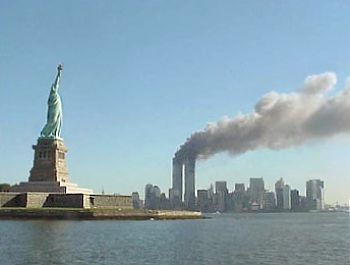In 2006, the BRE Centre for Fire Safety Engineering were involved in a series of large fire tests in a tower block in the Dalmarnock area of Glasgow. For details click here.

Did you know…?
A short history of the Dalmarnock building block before and after the Fire Tests.
The area of Dalmarnock was once heavily industrialised1. Sir William Arrol & Co. had its extensive engineering works there from 1873. From its beginnings in boiler making, the firm later became renowned for its achievements in the field of Structural engineering. Amongst the many bridges constructed throughout Britain by this firm, were the Forth Railway Bridge and Forth Road Bridge, the Humber Bridge and London's Tower Bridge. The company was eventually taken over by Clarke Chapman in 1969 and the Dalmarnock Works closed in 1986.
During the Second World War, the east side of Summerfield Street was bombed. Consequently, as part of the GEAR (Glasgow East Area Renewal) which took place during the '60s and '70s, most of the Victorian red-sandstone tenements from the neighbouring area were demolished, some were renovated, and a new housing scheme was built. The latter consisted of four 23 storey tower blocks and ‘H-block’ maisonettes.
The quartet of 23 storey tower blocks on the Millerfield estate in the south eastern corner of Dalmarnock, Glasgow, was formed by: 42, 403 and 504 Millerfield Road together with 1315 Allan Street. Approved in Phase 1 of the Summerfield project in 1962, construction was carried out by Laidlaw using the Prometo method. The design was by local architects, Parry & Hughes. The buildings were completed in 1964 and contained 132 flats each. Although initially popular with residents for being a vast improvement on the slums that predated post war development, lack of investment and maintenance made the block unpopular and the building housed fewer and fewer tenants.
In a massive regeneration effort to turn Dalmarnock into a potential Commonwealth 2014 Games village, the 4 tower blocks together with twelve maisonettes were demolished in different phases. On Sunday the 3rd of February 2002 at 11 AM, both 40 and 50 Millerfield Road blocks were demolished. They were the first high-rise demolition since a woman was tragically killed in 1993 as she watched the ill-planned implosion of Queen Elizabeth Square. The operation cost Glasgow City Council £1.2m to hire Yorkshire-based Controlled Demolition Group Ltd. Despite doing their best to keep the blow down secret, a small crowd had gathered to watch, but this time none of them were injured.
In January 2005, the decision was made by the Glasgow Housing Association to demolish 131 Allan Street. This came after the two other blocks in the scheme had been demolished 3 years before. All residents were rehoused by August 2006, with East End Community Homes doing their best to accommodate them all within the Dalmarnock/Bridgeton area, although the building was well below capacity. After almost a year preparation, the tower block was blown down in just 5 seconds by Safedem of Dundee and John F. Hunt using 85kg of explosives on the 5th of July 2005.
4 Millerfield Place was the one used for the Dalmarnock Fire Tests5 and the last to be demolished. Complications with preparing the building for demolition prevented it from being imploded in late-February 2007 as planned. There’s a version saying that “this was possibly as a result of an experiment into high rise fires conducted by the University of Edinburgh in 2006 affecting the structure's stability”. At 11 AM on the 9th of September 2007, this last block was finally demolished, leaving the entire Millerfield estate empty and awaiting new development which is ongoing by now.
The following is an interesting comment from a former tenant of one of these flats6: “I was there when the third multi-story was demolished, same as I was there when the first two came down, it was so sad for all of our families who have moved out of the area and the ones who still live in Dalmarnock as most of them spent their childhood days going to Springfield School in Allen St, if they didn't live in the flats they had friends and family who did. Dalmarnock was always a great place to live, I raised my family in the 70/80s. What a community we were in those days, I am always proud to say my son's came from Sunnybank St. Dalmarnock, getting back to the high flats, I remember in the winter months taking my lads to primary school in Allen St and taking the shortcut through the Millerfield flats, the wind was so strong it would blow us off our feet. I know Dalmarnock is going to be a brilliant place for the Commonwealth village, fingers crossed, let all the athletes come here and see what friendship is all about.”
So as we can see after this short story, there’s a curious succession of events specifically related to the high-rise used for the tests: the area was originally part of a structural engineering firm – notably the one that built both Forth Bridges – then came the very well known Dalmarnock Fire Tests, and finally ending its days being demolished on a 9/11. Recapitulating: structural engineering + Forth Bridge (there’s a photo of the beautiful railway bridge decorating Prof. Torero’s office) + fire tests + 9/11… strange coincidence...? J
By Agustin Majdalani
Demolition videos (131 Allan Street and 4 Millerfield Place):
http://www.youtube.com/watch?NR=1&v=-HzNwoWwEfQ
http://www.youtube.com/watch?v=jeObBJjB8Xs&feature=related
http://www.youtube.com/watch?v=-HzNwoWwEfQ&feature=related
http://www.youtube.com/watch?v=BteoagqYYFI
http://www.youtube.com/watch?v=VunUSR5znd8
http://www.youtube.com/watch?v=jB4g5rZtL4c&feature=related
Demolition photos:
http://www.gha.org.uk/content/mediaassets/Millerfieldgallery/millerfield/index.htm























